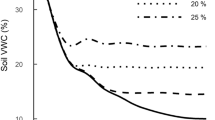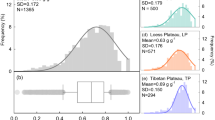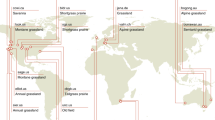Abstract
Across 30 grassland sites in New Zealand that ranged from native alpine grasslands to low elevation improved pastures, there were consistent patterns of leaf and root traits and significant differences between native and non-native grasses. Plants of high altitude sites have low N concentrations in both their leaves and roots, have thick leaves and roots, yet no differences in tissue density or photosynthetic water use efficiency when compared to plants of low altitude sites. Both the leaves and roots of the low altitude plants were enriched in 15N relative to the plants of higher altitude, indicating that the low-N set of traits is associated with a more closed N cycle at high altitude. A second independent set of correlations shows that plants of wetter habitats have lower photosynthetic water use efficiency (more negative ∂13C) and lower leaf and root tissue density than the plants of drier sites. For both leaves and roots, plants of native species consistently had traits associated with lower resource availability: lower N concentrations, denser tissues, more negative ∂15N, and more positive ∂13C than non-native species. If root %N is correlated with root longevity as has been shown in other systems, root longevity may be able to be predicted from simple measurements of leaf %N, though a hysteresis in the relationship between leaf and root N concentrations may make prediction of high longevity roots difficult.




Similar content being viewed by others
Explore related subjects
Discover the latest articles and news from researchers in related subjects, suggested using machine learning.References
Aerts R, Berendse F (1989) Above-ground nutrient turnover and net primary production of an evergreen and a deciduous species in a heathland ecosystem. J Ecol 77:343–356
Baruch Z, Goldstein G (1999) Leaf construction cost, nutrient concentration, and net CO2 assimilation of native and invasive species in Hawaii. Oecologia 121:183–192
Berendse F, Schmitz M, De Visser W (1994) Experimental manipulation of succession in heathland ecosystems. Oecologia 100:38–44
Boone RD, Nadelhoffer KJ, Canary JD, Kaye JP (1998) Roots exert a strong influence on the temperature sensitivity of soil respiration. Nature 396:570–572
Burton AJ, Pregitzer KS, Hendrick RL (2000) Relationships between fine root dynamics and nitrogen availability in Michigan northern hardwood forests. Oecologia 125:389–399
Caldwell MM, Eissenstat DM, Richards JH, Allen MF (1985) Competition for phosphorus: differential uptake from dual-isotope-labelled soil interspaces between shrub and grass. Science 229:384–386
Craine JM, Froehle J, Tilman DG, Wedin DA, Chapin FS III (2001) The relationships among root and leaf traits of 76 grassland species and relative abundance along fertility and disturbance gradients. Oikos 93:274–285
Craine JM, Tilman DG, Wedin DA, Reich PB, Tjoelker MJ, Knops JMH (2002) Functional traits, productivity and effects on nitrogen cycling of 33 grassland species. Funct Ecol 16:563–574
Crawley MJ, Harvey PH, Purvis A (1996) Comparative ecology of the native and alien floras of the British Isles. Phil Trans R Soc Lond Ser B 351:1251–1259
Eissenstat DM, Wells CE, Yanai RD, Whitbeck JL (2000) Building roots in a changing environment: Implications for root longevity. New Phytol 147:33–42
Fitter A (1996) Characteristics and functions of root systems. In: Waisel Y, Eshel A, Kafkafi U (eds) Plant roots: the hidden half. Dekker, New York, pp 1–20
Garten CT, Van Miegroet H (1994) Relationships between soil nitrogen dynamics and natural 15 N abundance in plant foliage from Great Smoky Mountains National Park. Can J For Res 24:1636–1645
Grime JP, Thompson K, Hunt R, Hodgson JG, Cornelissen JHC, Rorison IH, Hendry GAF, Ashenden TW, Askew AP, Band SR, Booth RE, Bossard CC, Campbell BD, Cooper JEL, Davison AW, Gupta PL, Hall W, Hand DW, Hannah MA, Hillier SH, Hodkinson DJ, Jalili A, Liu Z, Mackey JML, Matthews N, Mowforth MA, Neal AM, Reader RJ, Reiling K, Ross-Fraser W, Spencer RE, Sutton F, Tasker DE, Thorpe PC, Whitehouse J (1997) Integrated screening validates primary axes of specialisation in plants. Oikos 79:259–281
Haselwandter K, Read DJ (1980) Fungal associations of roots of dominant and sub-dominant plants in high-alpine vegetation systems with special reference to mycorrhiza. Oecologia 45:57–62
Hendricks JJ, Nadelhoffer KJ, Aber JD (1993) Assessing the role of fine roots in carbon and nutrient cycling. Trends Ecol Evol 8:174–178
Hendricks JJ, Aber JD, Nadelhoffer KJ, Hallett RD (2000) Nitrogen controls on fine root substrate quality in temperate forest ecosystems. Ecosystems 3:57–69
Hogberg P (1997) Tansley review no. 95. 15 N natural abundance in soil-plant systems. New Phytol 137:179–203
Hooper DU, Johnson L (1999) Nitrogen limitation in dryland ecosystems: responses to geographical and temporal variation in precipitation. Biogeochemistry 46:247–293
Jackson RB, Canadell J, Ehleringer JR, Mooney HA, Sala OE, Schulze ED (1996) A global analysis of root distributions for terrestrial biomes. Oecologia 108:389–411
Jackson RB, Sala OE, Paruelo JM, Mooney HA (1998) Ecosystem water fluxes for two grasslands in elevated CO2: a modeling analysis. Oecologia 113:537–546
Klingensmith KM, Van Cleve K (1993) Patterns of nitrogen mineralization and nitrification in floodplain successional soils along the Tanana River, interior Alaska. Can J For Res 23:964–969
Körner C, Renhardt U (1987) Dry matter partitioning and root length/leaf area ratios in herbaceous perennial plants with diverse altitudinal distribution. Oecologia 74:411-418
Leathwick JR, Burns BR, Clarkson BD (1998) Environmental correlates of tree alpha-diversity in New Zealand's primary forest. Ecography 21:235–246
Lee DE, Lee WG, Mortimer N (2001) Where and why have all the flowers gone? Depletion and turnover in the New Zealand Cenozoic angiosperm flora in relation to palaeography and climate. Aust J Bot 49:341–356
Monk C (1966) An ecological significance of evergreenness. Ecology 47:505–505
Nadelhoffer KJ (2000) The potential effects of nitrogen deposition on fine-root production in forest ecosystems. New Phytol 147:131–139
Nadelhoffer K, Shaver G, Fry B, Giblin A, Johnson L, McKane R (1996) 15 N natural abundances and N use by tundra plants. Oecologia 107:386–394
Norby RJ, Jackson RB (2000) Root dynamics and global change: Seeking an ecosystem perspective. New Phytol 147:3–12
Reich PB, Walters MB, Ellsworth DS (1997) From tropics to tundra: global convergence in plant functioning. Proc Natl Acad Sci USA 94:13730–13734
Ryser P (1996) The importance of tissue density for growth and life span of leaves and roots: a comparison of five ecologically contrasting grasses. Funct Ecol 10:717–723
Schlaepfer B, Ryser P (1996) Leaf and root turnover of three ecologically contrasting grass species in relation to their performance along a productivity gradient. Oikos 75:398–406
Smith MD, Knapp AK (2001) Physiological and morphological traits of exotic, invasive exotic, and native plant species in tallgrass prairie. Int J Plant Sci 162:785–792
Sokal R, Rohlf J (1994) Biometry: the principles and practice of statistics in biological research. Freeman, New York
Tilman D (1987) Secondary succession and the pattern of plant dominance along experimental nitrogen gradients. Ecol Monogr 57:189–214
Van Noordwijk M, Maartikainen P, Bottner P, Cuevas E, Rouland C, Dhillion S (1998) Global change and root function. Global change biology 4:759–772
Visser EJW, Boegemann GM, Van De Steeg HM, Pierik R, Blom CWPM (2000) Flooding tolerance of Carex species in relation to field distribution and aerenchyma formation. New Phytol 148:93–103
Vitousek PK, Aber J, Howarth RW, Likens GE, Matson PA, Schindler DW, Schlesinger WH, Tilman GD (1997) Human alteration of the global nitrogen cycle: source and consequences. Ecol Appl 7:737-750
Williams PA, Grigg JL, New P, O'Connor KF (1978) Macro-elements within shoots of tall-tussocks (Chionochloa), and soil properties on Mt Kaiparoro, Wairarapa, New Zealand. N Z J B 16:255-260
Yin X, Perry J (1991) Factors affecting nitrogen concentration of fine roots in forest communities: regression analysis of literature data. For Sci 37:374-382
Acknowledgements
This research was supported by a Landcare Research fellowship to J. M. C. and W. G. L. Kendra McLauchlan, Jo Wass, and Gudrin Wells provided invaluable assistance throughout the project. Kendra McLauchlan, Joe Fargione, and two anonymous reviewers helped improve the manuscript.
Author information
Authors and Affiliations
Corresponding author
Rights and permissions
About this article
Cite this article
Craine, J.M., Lee, W.G. Covariation in leaf and root traits for native and non-native grasses along an altitudinal gradient in New Zealand. Oecologia 134, 471–478 (2003). https://doi.org/10.1007/s00442-002-1155-6
Received:
Accepted:
Published:
Issue Date:
DOI: https://doi.org/10.1007/s00442-002-1155-6




